Lab Grown Diamonds vs Natural Diamonds: Pricing Insights
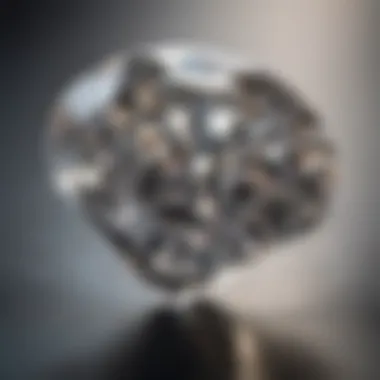
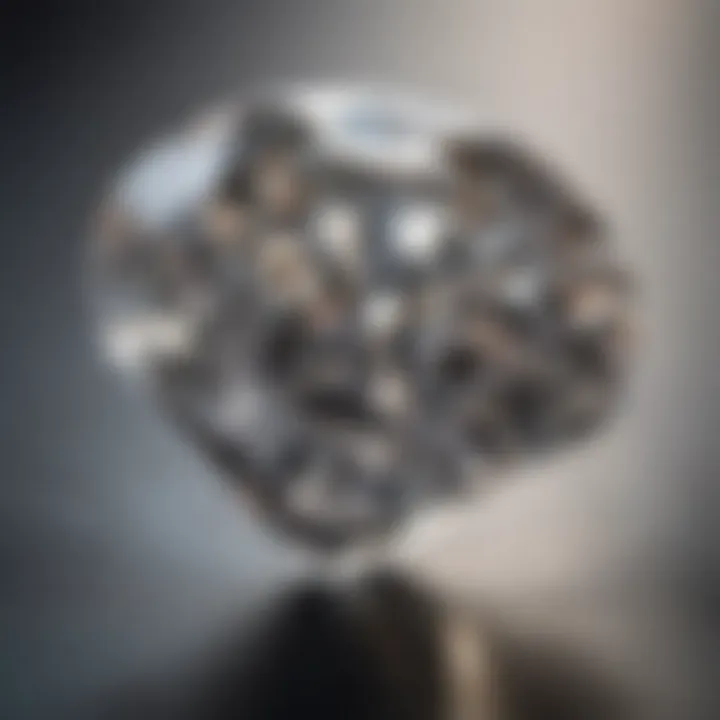
Intro
In recent years, the conversation surrounding diamonds has shifted considerably. The rise of lab-grown diamonds, alongside the traditional allure of natural diamonds, has prompted many individuals to rethink their understanding of value and pricing in the gem market. With a myriad of choices available, it becomes essential to delve into the facets that make these gemstones distinct.
From an economic perspective to ethical considerations, the decision to purchase a diamond now encompasses much more than mere aesthetic appeal. Potential buyers need to grasp the nuances between these two categories of diamonds. The phrases ‘inherent value’ and ‘synthetic’ seem to spark debates that often lead to passionate discussions among gem enthusiasts, collectors, and jewelry designers alike.
As we explore the intricacies of lab-grown diamonds and natural diamonds, let's dissect the characteristics that define each, the pricing structures, and the moral implications that come with these sparkling stones. A close look at market trends and consumer preferences will provide a clearer picture to aid in making informed choices.
This comprehensive analysis aims to shed light on how diamonds—both lab-grown and natural—fit into the broader narrative of gemology today. Understanding these elements allows for a more profound appreciation of what these magnificent gems signify in contemporary society.
Gemstone Overview
Definition and Characteristics
Diamonds, known for their brilliant clarity and unmatched hardness, are carbon in its most compressed form. Natural diamonds form over millions of years deep within the Earth’s mantle, a process involving intense heat and pressure. Conversely, lab-grown diamonds, created in controlled environments, mimic these geological processes, resulting in stones almost identical to their natural counterparts.
Some distinguishing characteristics include the following:
- Origin: Natural diamonds are mined from the Earth, whereas lab-grown diamonds are synthesized in laboratories.
- Cost: Typically, lab-grown diamonds are more affordable than natural ones, often costing 30-50% less.
- Sustainability: Lab-grown diamonds carry an eco-friendlier label, as they don't rely on mining which can disrupt ecosystems.
Classification of Gemstones
Gemstones fall broadly into two categories: precious and semi-precious. While diamonds belong to the precious group, their classification can differ based on origin. Here’s a breakdown:
- Natural Diamonds: Formed over geological timescales, these gemstones are renowned for their rarity and value.
- Lab-Grown Diamonds: Manufactured stones that replicate the natural formation process, gaining popularity for their ethical considerations and pricing.
- Other Diamonds: Fancy colors, industrial-grade diamonds, and the like, cater to specific applications and markets.
Understanding these classifications is central to navigating the current gem landscape. With ongoing advancements in technology and changing consumer preferences, the boundaries of what constitutes a diamond are being reshaped.
"In the world of diamonds, the origin does add a unique story, but the beauty lies in the sparkle, regardless of the creation tale."
The distinctions outlined here play a significant role in how diamonds are perceived, both in terms of desirability and value in the marketplace. As we progress through this analysis, we will touch on the properties of gemstones next, highlighting both their physical and chemical traits.
Prologue to Diamonds
Diamonds have long captivated the human imagination. They’re not merely gemstones; they symbolize wealth, commitment, and the intricacies of natural processes that form under the Earth's crust. In this article, we delve into the fundamentals of diamonds, laying the groundwork for a nuanced discussion comparing lab grown and natural varieties. Understanding diamonds is crucial to grasping the economic and ethical considerations surrounding these two types.
Defining Diamonds
At their core, diamonds are a form of carbon arranged in a crystal lattice structure. This unique formation gives them unmatched hardness and brilliance. While many folks know diamonds as exquisite gemstones for rings or pendants, they also hold significant scientific value in fields such as geology and material science. In fact, the characteristics of diamonds can tell stories about geological events, including the temperatures and pressures prevalent during their formation.
When we talk about diamonds, we typically refer to their two main categories—lab-grown and natural. Natural diamonds take millions of years to form deep within the Earth, where intense heat and pressure compress carbon into their crystalline structure. On the other hand, lab-grown diamonds are created in controlled environments, mimicking the natural processes but achieving results in mere weeks or months. Both types share the same chemical properties, yet their origins and the implications of those origins shape the narratives surrounding them.
Significance in Culture and Society
Diamonds hold a profound place in the tapestry of human culture. Across various societies, they signify status, beauty, and even love. The concept of the diamond engagement ring is an enduring symbol in many cultures, stemming from marketing campaigns that defined societal norms around commitment. Such deep-rooted perceptions can affect consumer choices and the value attributed to different diamond types.
In addition to their cultural significance, diamonds have played pivotal roles in economies worldwide. Countries rich in natural diamonds, like Botswana and Russia, have seen these gemstones fuel economic development and stability. Meanwhile, our growing understanding of lab-grown diamonds has led to ethical discussions about production methods and supply chains, particularly concerning sustainability and conflict-free sourcing.
In summary, a comprehensive understanding of diamonds sets the stage for comparing their lab-grown and natural counterparts. The details we glean from history, culture, and even scientific principles elevate the conversation about their pricing and value, preparing us for a more informed exploration of the gemstone industry.
Lab Grown Diamonds: An Overview
Lab grown diamonds are becoming an important topic in the gemstone industry. The reason for that is simple: they provide an alternative to natural diamonds while also addressing many concerns that come along with mining. As society becomes more aware of environmental issues, and consumers become more conscious about the origins of their purchases, lab grown diamonds present a viable option. Their relevance is not only rooted in price differences but also in characteristics that offer buyers different value propositions.
Production Techniques and Methods
High Pressure High Temperature (HPHT)
High Pressure High Temperature (HPHT) is one of the pioneering methods for creating lab grown diamonds. The technique simulates the conditions under which natural diamonds form in the earth's mantle. This means immense pressure and temperature. The process typically involves placing carbon material under such conditions for a period of weeks or months.
The key characteristic of HPHT is its authenticity. It allows for the creation of diamonds that can be remarkably similar in properties to their natural counterparts. It’s a preferred choice for individuals who desire diamonds that mirror the beauty and qualities of natural stones yet are produced in a controlled environment.
One unique feature of HPHT is the ability to create colored diamonds, which is often less common in natural formations. However, it can be expensive due to the heavy machinery and conditions required. Still, many consumers appreciate the quality and beauty that come with HPHT diamonds.
Chemical Vapor Deposition ()
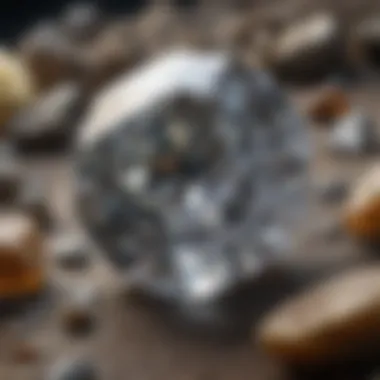

Chemical Vapor Deposition (CVD) is another popular method for producing lab grown diamonds. This process introduces carbon gases into a vacuum chamber, where they are heated and break down, allowing carbon atoms to deposit on a substrate and form a diamond. The method offers precise control over the conditions under which diamonds grow.
CVD diamonds are notable for their clarity and ability to be produced in relatively large sizes, often surpassing those created through HPHT. This capability makes CVD a favorable method for buyers pursuing larger stones without the price tag commonly associated with natural diamonds.
A unique advantage of CVD is the potential to create diamonds with fewer impurities, which can lead to higher quality stones. Nonetheless, some purists in the gem community argue they lack the soul that comes from a naturally formed diamond, making the emotional appeal a consideration alongside the financial aspects.
Characteristics and Properties
Physical Properties
The physical properties of lab grown diamonds are a significant part of their appeal. Just like their natural counterparts, they boast remarkable hardness, scoring a perfect 10 on the Mohs scale. This makes them incredibly durable and suitable for daily wear in jewelry.
The refractive index of lab grown diamonds is essentially identical to natural diamonds, meaning they sparkle just as brilliantly. This characteristic solidifies their place within the luxury market.
However, one downside to their physical properties may include a perception issue. Some may question if a lab grown diamond, despite its properties, holds the same allure as a natural diamond. Additionally, they may not carry the same historic narrative associated with a long-standing geological formation.
Chemical Composition
When it comes to the chemical composition, both lab grown and natural diamonds are made of carbon atoms arranged in a crystal structure. Thus, they share almost identical chemical properties, leading to similar appearance and performance in jewelry.
The key difference here is trace elements or impurities. Lab grown diamonds often have fewer inclusions and a more uniform appearance than natural diamonds, which can introduce color variations based on how they were formed.
This meticulous control on composition can be beneficial for those seeking perfection in clarity. However, for some consumers, the natural variations found in earth-mined diamonds can evoke a charm and uniqueness that is hard to replicate in a lab format.
Natural Diamonds: Understanding Their Origins
Understanding natural diamonds provides context and depth to the ongoing dialogue about their value, origins, and how they contrast with lab-grown alternatives. Unique geologic processes give rise to these stones, forming them deep within the Earth’s mantle under intense heat and pressure over millions of years. This time-consuming formation contributes not only to their value but also to their significance in various cultures around the world. Furthermore, the relationship between diamonds, their rarity, and ethical considerations surrounding their sourcing plays a crucial role in shaping consumer choices.
Formation Process
The formation process of natural diamonds is a fascinating journey that begins deep beneath the Earth’s crust. The extreme conditions found there – high temperatures exceeding 2,200 degrees Fahrenheit and pressures around 725,000 pounds per square inch – allow carbon atoms to bond in a specific arrangement, creating the crystal structure we recognize as diamond. This process usually takes a million years or more, adding to the allure of natural diamonds.
Once formed, diamonds might travel to the surface through volcanic eruptions that create kimberlite pipes. These geologically rare conduits are often the areas where mining efforts focus, as they are the primary source of naturally occurring diamonds. The uniqueness of natural diamonds lies not only in their creation but also in their provenance, which tells a story that connects them to a specific time and place.
Geographical Distribution
Natural diamonds are not just geological curiosities; their locations and origins contribute significantly to their identity and market value. They’re mined across the globe, but only select regions yield economically viable quantities.
Major Mining Regions
Several key destinations are renowned for their diamond yield. A few notable mining regions include:
- Africa: Home to some of the largest diamond mines, countries like Botswana and South Africa play pivotal roles. The significance of Africa in the diamond industry cannot be overstated; these regions supply a substantial percentage of the world’s diamonds.
- Russia: Known for producing exceptional quality diamonds, Russia's mines are among the largest globally, controlling a significant portion of diamond output.
- Canada: Emerging as a top player in the diamond market, Canada’s environmental regulations have reshaped how diamonds are mined, a positive step that caters to ethically-minded consumers.
These regions not only have economically rich deposits but resonate with the cultural stories connected to diamonds. Their unique geological formations provide the ideal conditions for diamonds to form and be extracted, enhancing their desirability.
Rarity Factors
Rarity plays a quintessential role in the value proposition of natural diamonds. A critical aspect of rarity is that not every diamond is created equal. Factors contributing to their scarcity include:
- Quality and Characteristics: Diamonds are assessed based on the Four Cs – carat, cut, color, and clarity. These characteristics significantly influence their market value. A flawless diamond of substantial size is much rarer than a smaller, included stone.
- Natural Formation Limits: Because the conditions needed for diamond formation are specific and rare, not all carbon deposits turn into diamonds. This natural limitation enhances their rarity.
- Mining Restrictions: Many mining operations face environmental and ethical pressures. The limited availability of accessible and acceptable mining locations means that as demand grows, the supply can’t always keep pace.
The unique feature of rarity gives natural diamonds a profound allure, reinforcing their status as symbols of luxury and commitment. This scarcity, however, raises questions for consumers about sustainability and ethics in light of the alternatives available, notably lab-grown diamonds.
Price Comparison: Lab Grown vs Natural Diamonds
Understanding how lab grown diamonds stack up against their natural counterparts in terms of pricing is essential for anyone looking to invest in or simply appreciate these gemstones. These prices are influenced by a myriad of factors, and exploring this comparison can encourage buyers to make informed decisions based on not only aesthetics but also budgetary considerations.
Comparing the price of lab grown diamonds to natural diamonds is especially relevant today, as consumers become more aware of their choices, and as the market itself evolves. While lab grown diamonds generally offer a more user-friendly price tag, natural diamonds carry an allure of rarity that captivates many enthusiasts.
Whether one is looking for an engagement ring or simply a dazzling addition to a collection, understanding these distinctions is paramount.
Current Market Prices
At the heart of any purchasing decision are the prices. Lab grown diamonds typically come in at significantly lower price points than natural stones. While it’s common to find lab grown diamonds priced at 20% to 40% less than comparable natural diamonds, this can fluctuate based on several factors.
The market for lab grown diamonds has exploded over recent years, meaning prices can vary quite a bit. For example, a high-quality one-carat lab grown diamond might sell for around $3,000, while a similar natural counterpart can easily reach double that, or more. Such price differences are no small potatoes and can influence the final choice greatly.
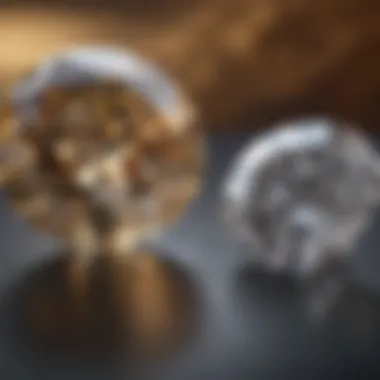
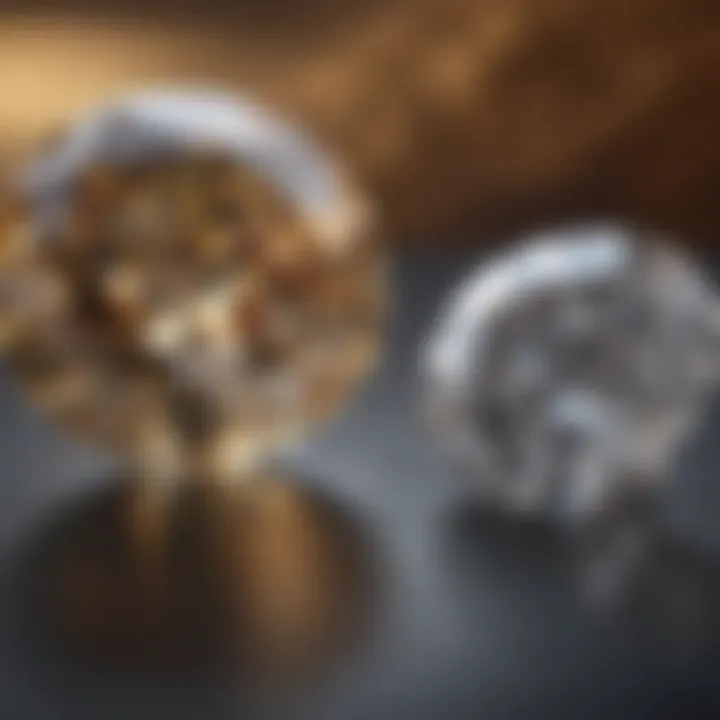
Factors Influencing Pricing
The differences in pricing of diamonds hinge on several elements. Here’s how they break down:
Production Costs
Production costs are vital to understanding why lab grown diamonds are generally more affordable. The methods used—mainly High Pressure High Temperature (HPHT) and Chemical Vapor Deposition (CVD)—allow for a control over the manufacturing process that's simply not possible with natural diamonds, which depend on geological processes that take billions of years.
These lab techniques enable producers to create gems swiftly, thus keeping production costs relatively low.
Moreover, lab grown diamond technology is advancing rapidly, which may further reduce costs. The continual improvements in production methods could translate into lower prices for consumers down the line. However, one must also note that while production costs are lower, the initial investment in the machinery and facilities can be significant, creating an initial financial barrier.
Market Demand
Market demand plays a crucial role in pricing as well. As consumers become more educated about lab grown diamonds, interest has surged. The demand for ethically sourced products, coupled with the appeal of lower prices, has led to an uptick in sales for lab grown varieties.
However, it’s also essential to realize that natural diamonds still hold a cherished place in the market. Their rarity fuels a higher demand that propels prices skyward. The intrinsic value that buyers often associate with natural diamonds, stemming from their origin and history, continues to maintain its appeal even in the face of more attractive alternatives.
"While market conditions can change, the emotional investment or perceived value tied to natural diamonds often keeps them firmly at elevated price points."
Overall, the interplay between production costs, technological advancements, and market demand shapes the landscape for both lab grown and natural diamonds, influencing their worth and accepted value in society.
Consumer Perception and Value
Understanding how consumers view diamonds—whether lab grown or natural—is fundamental in assessing their pricing and overall value. In a world where sustainability and ethical sourcing are gaining traction, buyer preferences are shaped not just by the properties of the diamond, but also by the values they represent. This exploration into consumer perception zeroes in on emotional connections, self-image associations, and the financial considerations tied to both diamond types.
Emotional and Sentimental Value
Diamonds, often dubbed the stone of love, have long been associated with significant life events—think engagements, anniversaries, and celebrations of milestones. The emotional weight tied to a diamond is profound; it symbolizes commitment, romantic gestures, and legacy. This sentimental aspect isn’t just a superficial attachment; it draws from deep cultural roots where diamonds are seen as timeless tokens of affection. For many, the mere presence of a diamond can stir memories and feelings that are irreplaceable.
For instance, a woman might treasure the diamond her grandmother wore, not only for its beauty but also for its history.
- Personal Connections: These stones often come with stories that enhance their worth well beyond the material. People may choose a particular diamond not solely for clarity, carat, or cut, but for the narrative it'll carry.
- Symbolic Representation: Lab grown diamonds can offer similar aesthetics and qualities, yet their origin often results in a divided reception. Some buyers find value in the idea of a sustainably sourced stone, while others might feel they lack the "soul" of natural diamonds, which have travelled through centuries of geological processes.
Resale Value Considerations
When it comes to the question of resale, the market isn’t straightforward. While a natural diamond typically holds more resale value due to its rarity and established history, lab grown alternatives are gaining traction. However, consumers need to be aware of several factors that influence resale prices as they contemplate their investment.
- Market Demand: Natural diamonds have an established market that values their unique heritage. On the flip side, lab grown diamonds are less common in resale transactions, which may lead to unexpectedly lower prices in the second-hand market.
- Depreciation Rate: Resale markets for lab grown diamonds are still developing; they often depreciate quicker than their natural counterparts.
"Understanding how pricing fluctuates will aid consumers in making informed decisions about their purchases."
- Certification and Documentation: A well-documented purchase can help maintain value over time. Diamonds that come with certification—be it mined or grown—tend to fare better.
Ethical Implications of Diamond Choices
The choice between lab grown and natural diamonds is not just a matter of personal preference or budget; it’s a decision that carries substantial ethical weight. This elemenet reflects growing consumer awareness about the origins and production of diamonds, alongside the associated environmental and socio-political issues. As consumers become better informed, they demand transparency in how these gemstones are sourced and processed. In the shifting landscape of the diamond market, ethical considerations are becoming increasingly relevant, serving as a guideline that will shape future purchases.
Environmental Impact
Lab grown diamonds are often touted as environmentally friendly alternatives to their natural counterparts. The traditional diamond mining process has significant environmental consequences, including habitat destruction, biodiversity loss, and substantial water usage. For instance, digging deep into the Earth to extract these precious stones can lead to soil erosion and pollution of nearby waterways, adversely affecting local ecosystems.
On the flip side, while lab grown diamonds require energy for their production, they generally have a lower carbon footprint. The new technologies used to create these diamonds are becoming more efficient. Some facilities utilize renewable energy sources, which drastically reduce the environmental toll.
Consider some of these aspects:
- Water Usage: Mining consumes massive amounts of water, while lab-grown procedures are less resource-intensive.
- Soil Disruption: The mining process often leads to irreversible changes in landscapes.
- Carbon Emissions: Conventional diamond extraction is associated with high CO2 emissions, though advancements in lab-grown technology are diminishing this impact.
"The choice a consumer makes can either contribute to environmental degradation or promote sustainable practices."
Conflict Diamonds vs Ethical Sourcing
The specter of conflict diamonds looms large over the industry. These gems, often mined under dire circumstances, fund wars, human rights abuses, and oppressive regimes. The global effort to eliminate conflict diamonds has led to initiatives like the Kimberley Process, aimed at increasing transparency in diamond sourcing. Nevertheless, loopholes still exist, and not every diamond can be assured free of conflict.
In contrast, lab grown diamonds provide a clean alternative. They are created in controlled environments, which allows for full traceability. As consumers lean towards ethical sourcing, these lab-grown options resonate well with values centered around fairness and transparency.


Key considerations include:
- Human Rights: Natural diamond mining has been linked to numerous human rights violations.
- Supply Chain Transparency: Lab grown diamonds offer clarity regarding their origins, minimizing the risk of ethical compromise.
- Consumer Responsibility: Increasingly, buyers are expected to be aware of the ethical implications surrounding diamond sourcing.
Both consumers and the industry must acknowledge these ethical concerns as part of the larger conversation surrounding diamonds. As preferences shift, the implications of those choices send ripples through the gemstone market and beyond.
The Future of Diamond Pricing
Understanding the future of diamond pricing is not just an academic exercise; it's pivotal for consumers, sellers, and everyone who has a stake in the diamond industry. With the rise of lab-grown diamonds and shifts in consumer preferences, pricing dynamics are evolving rapidly. The factors influencing these changes are multifaceted, ranging from technological advancements to market psychology.
As we navigate this new terrain, it becomes critical to consider how these elements interact. For instance, consumers are becoming increasingly aware of the ethical implications surrounding diamond sourcing, which directly impacts their purchasing decisions. Furthermore, economic trends indicate that the gap between lab-grown and natural diamonds is not just an issue of production cost but also of perceived value and societal acceptance.
"The only constant in the diamond industry is change itself."
Market Trends and Predictions
Market trends suggest a definitive shift towards lab-grown diamonds. Recent surveys indicate that younger consumers, especially Millennials and Gen Z, are showing a preference for these ethical alternatives. This demographic trend can lead to a significant reshaping of the market landscape. Factors contributing to this trend include:
- Sustainability: Eco-conscious buyers are more inclined to choose lab-grown gems, seeing them as a more responsible option.
- Cost Effectiveness: Lab-grown diamonds often come at a fraction of the price of their natural counterparts, enticing budget-conscious individuals.
- Customization: Technological capabilities allow for more unique designs in lab-grown diamonds, appealing to a desire for personalization.
Industry experts predict that, in the coming years, lab-grown diamonds might capture as much as 20% to 30% of the market share. As consumers become more educated on the benefits and value of both options, this percentage could continue to grow.
Impact of Technology on Production Costs
Technology plays a crucial role in shaping the future of diamond pricing. The methods used to create lab-grown diamonds, like Chemical Vapor Deposition (CVD) and High Pressure High Temperature (HPHT), are becoming progressively more efficient and less expensive. This efficiency is a double-edged sword. While it allows for lower retail prices, it raises questions about the long-term value of these diamonds compared to their natural brethren.
Here are key points to consider regarding the impact of technology:
- Cost Reduction: New production techniques drive down the prices of lab-grown diamonds, making them accessible to a broader audience.
- Quality Improvements: As technology evolves, so does the quality of lab-grown diamonds, making them competitive with natural ones.
- Market Saturation: An influx of affordable lab-grown options could lead to market saturation, which might affect pricing structures across the board.
In a landscape where both technology and consumer preferences are shifting, the implications for natural diamonds remain significant. Their rarity and the narrative of being formed over millions of years will continue to hold value—but the status quo is undoubtedly being challenged.
Closure
When it comes to understanding the differences between lab grown and natural diamonds, the conclusion serves as the cornerstone of the entire discussion. It pulls together the threads of knowledge we’ve unraveled throughout this article, offering clarity about how each diamond type occupies its unique space in the market.
This nuanced understanding is vital, as it aids consumers in making informed choices that align with their values and expectations. Key elements to note include:
- Pricing Structures: Lab grown diamonds often present a more favorable price tag, making them attractive for budget-conscious buyers. Natural diamonds, with their inherent rarity and geological formation, typically command higher prices.
- Emotional and Sentimental Factors: Buyers should reflect on the personal significance of the diamond they choose. Natural diamonds carry a story tied to their origins, while lab grown diamonds can symbolize modernity and ethical considerations.
- Ethical Implications: The discussion around ethical sourcing and environmental impact is more pressing than ever. Consumers are increasingly looking for clarity on how their purchases affect the world.
- Market Trends and Future Projections: An eye towards future market trends shows rising popularity in lab grown options, influenced by both consumer preferences and technological advancements that lower production costs.
Ultimately, the decision on what type of diamond to purchase hinges upon these multifaceted considerations. Understanding these elements helps consumers navigate their choices with more confidence and assurance that they’re acquiring something that resonates with their personal beliefs and financial situations.
Summarizing Key Differences
As we reflect on the ongoing conversation around diamonds, it is essential to boil down the key differences that set lab grown diamonds apart from their natural counterparts. Here’s a concise recap:
- Creation Process:
- Cost:
- Market Perception:
- Engagement Trends:
- Natural diamonds form over billions of years under extreme heat and pressure deep within the Earth.
- Lab grown diamonds, on the other hand, are created in mere weeks through sophisticated technological processes like High Pressure High Temperature (HPHT) or Chemical Vapor Deposition (CVD).
- Lab grown diamonds are generally priced 20-40% lower than natural diamonds due to lower production costs and greater availability.
- Natural diamonds are often seen as more of an investment, given their historical value retention.
- Many consumers have a romantic association with natural diamonds, tied to tradition and statement-making.
- Lab grown diamonds are rapidly earning respect in the marketplace for their ethical production methods and lower environmental impact.
- A shift toward lab grown diamonds is noticeable, particularly among younger generations who prioritize sustainability.
By keeping these gaps in mind, buyers can better navigate their purchasing paths, ensuring they select a diamond that symbolizes their intentions.
Informed Decision Making for Consumers
In the quest for the perfect diamond, making an informed decision is crucial. The landscape of diamond availability today allows consumers to evaluate options more thoughtfully than ever before. Here are some strategies to ensure you are well-informed:
- Research and Verification:
- Consider Your Values:
- Seek Trusted Retailers:
- Price Comparisons:
- Look into all qualities, including the Four Cs—Cut, Clarity, Color, and Carat. Understand how these apply to both lab grown and natural diamonds.
- Insights can be gleaned from reputable sources such as Wikipedia or Britannica.
- Reflect on what matters most to you. Is it the historic prestige of a natural diamond, or the eco-friendly and ethical documentation that comes with a lab grown diamond?
- Partner with jewelers who provide transparent information about their stones, including certification and origin clarity.
- Don’t shy away from comparing prices between various retailers for similar specifications to find the best deal.
- Utilizing platforms like Reddit can assist in gathering real-time experiences and advice from other consumers.
By employing these considerations in the decision-making process, individuals can feel empowered in their purchases. Whether selecting a natural diamond steeped in tradition, or a lab grown diamond appealing for its modernity, ensuring due diligence reflects in a choice that feels both personal and purposeful.



